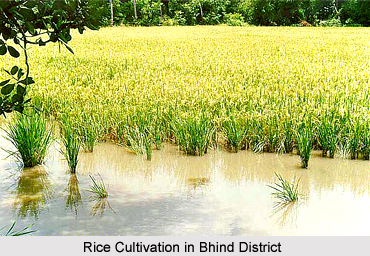 Economy of Bhind District is based in the agriculture. Agriculture is the main occupation of the people in the district and dairy is the main supplementary source of income of the farmers in the district. The soil is fertile, and the district is well drained by the Chambal River and Sindh River and the tributary streams - Kwari River and Pahuj River. The district can be credited with a high percentage of the net sown area. Traditional cropping practices along with old conventional tools are still used commonly but the farmers have readily adopted the improved models of the traditional tools or the new agricultural machinery as well.
Economy of Bhind District is based in the agriculture. Agriculture is the main occupation of the people in the district and dairy is the main supplementary source of income of the farmers in the district. The soil is fertile, and the district is well drained by the Chambal River and Sindh River and the tributary streams - Kwari River and Pahuj River. The district can be credited with a high percentage of the net sown area. Traditional cropping practices along with old conventional tools are still used commonly but the farmers have readily adopted the improved models of the traditional tools or the new agricultural machinery as well.
Bhind Canal Project has literally been the backbone of the district irrigation since long. It was constructed back in the year 1919 and was completed by 1933 under the erstwhile Gwalior State regime. Tank and wells are used to irrigate in the district.
Both Rabi and Kharif crops are cultivated in the district. Rabi cultivation has gained significantly along with increase in irrigation in this area. In Kharif crops, the development of certain crops like rice and bajra has given particular attention and has registered progress. This growth of Kharif crops has evidently been due to decreasing popularity of other food crops consisting mostly of millets, which had earlier occupied a much larger area together under them.
Animal husbandry is another sector of economy of Bhind District. Further, poultry farming in this area was formerly limited more or less to some particular communities and generally in the economically weaker sections. With the increasing popularity of eggs, poultry farming is now being pursued by larger section of the population in the district. Moreover, near about 417 small scale industries have been established through District Industry Centre, Bhind. Around 2340 people are employed in these industries. Ghee manufacturing in Bhind is an important industry, along with rearing of livestock for milk and other milk products. Most of the industrial activities in Bhind District are concentrated at Bhind. In order to attract new entrepreneurs a scheme of establishing a Semi-Urban Industrial Estate was launched at Bhind during 1962 - 1963, where in developed plots and constructed sheds were provided to industrial units. Most of the large and medium scale industries are located at Malanpur. The economic importance of the local forests is limited to fuel only.






